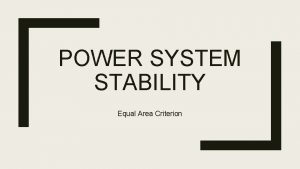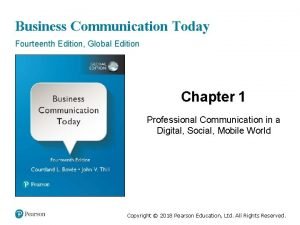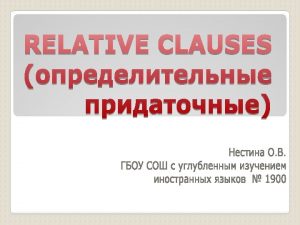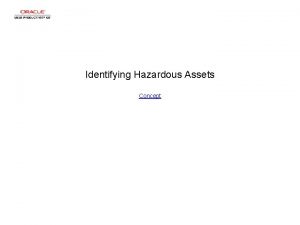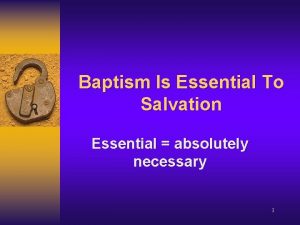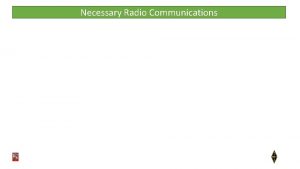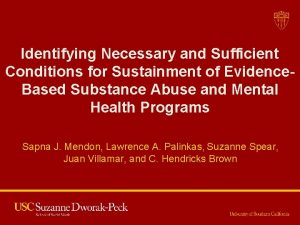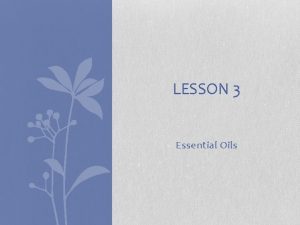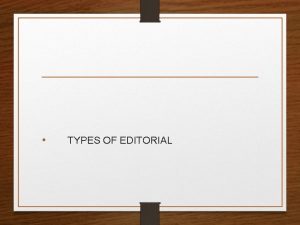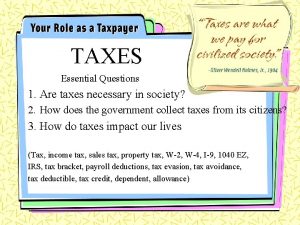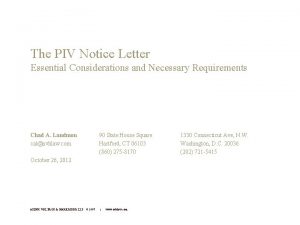Identifying o gives necessary information essential to the























- Slides: 23


� Identifying (определительнoе) gives necessary information essential to the meaning of the main sentence (уточняет значение определяемого слова) � The woman who lives next door is on vacation. � Non-Identifying (неопределительнoе) gives extra information and is not essential to the meaning of the main sentence (сообщает дополнительную информацию об определяемом слове) � Mrs. Smith, who lives next door, is on vacation.



identifying Those who have not yet registered should relative do so at once. clause is not Те, кто еще не put in зарегистрировался, commas �An должны сделать это незамедлительно (определительное). Identifying relative clauses

�A non – identifying relative clause is put in commas �Yesterday we visited the City Museum, which I'd never been to before. �Вчера мы ходили в Городской музей, в котором я никогда раньше не был. Non-identifying relative clauses




�My students, who are all adults, are learning English to get a more prestigious job. �Мои студенты, все из которых взрослые, изучают английский, чтобы найти более престижную работу. Non-identifying relative clauses

�An identifying relative clause is introduced with: �WHO/THAT (PEOPLE) �WHICH/THAT (THINGS) �WHOSE (PEOPLE. ANIMALS AND OBJECTS TO SHOW POSSESSION) �WHERE (PLACE) �WHEN (TIME) �THE REASON (WHY) (REASON) Identifying relative clauses

�The man who / that you are looking for is not here. — Мужчины, которого вы ищете, здесь нет. �The book which / that you are looking for is not here. — Книги, которую вы ищете, здесь нет. �Do you remember the day when we first met? — Ты помнишь день, когда мы впервые встретились? Identifying relative clauses

�Who, that, which can be omitted when they are the object of the relative clause �The company that she works for is based in London. (That is the object) �= The company she works for is based in London. (That can be omitted) Identifying relative clauses

BUT: �The company that employs her is based in London. (That is the subject) �The company employs her (the company – the subject). The pronoun that can’t be omitted Identifying relative clauses

What bald words can be omitted? �Is there another time when I can call you? �Can you tell me where I can buy wrapping paper? Identifying relative clauses

�Do you remember the place where we stayed in last summer? �Have you seen the TV show whose catchphrase is “Deal no deal? ” �I wanted to have a heart-to-heart talk with you. This is the reason why I came to you. �Do you remember the day when we first met? Identifying relative clauses

�Who, that, which can be omitted when they are the object of the relative clause �When/that, omitted why can be �Where can be omitted when it is used with a preposition Identifying relative clauses

BUT: Who, which, that can’t be omitted when they are the subject of the relative clause Whose is never omitted Identifying relative clauses

�A non –identifying relative clause is introduced with: �WHOM �WHICH �WHOSE �WHERE �WHEN Non-identifying relative clauses

�Yesterday we visited the City Museum, which I'd never been to before. �My students, who are all adults, are learning English to get a more prestigious job. �My students, many of whom are from Europe, are learning English to get a more prestigious job Non-identifying relative clauses

�The textbooks, which the students like, have lots of helpful examples. �Her previous manager, whose knowall manner she had never liked, retired six months ago. �We will never forget our honeymoon, when we were so happy. �Steve and Lora are currently staying in that little hotel in Valencia, where we spent our last holiday Non-identifying relative clauses


 Adjective
Adjective Identifying and non identifying adjective clauses
Identifying and non identifying adjective clauses Identify the essential
Identify the essential Essential non essential fatty acids
Essential non essential fatty acids Equal area criteria gives the information regarding
Equal area criteria gives the information regarding Communication model
Communication model Hát kết hợp bộ gõ cơ thể
Hát kết hợp bộ gõ cơ thể Frameset trong html5
Frameset trong html5 Bổ thể
Bổ thể Tỉ lệ cơ thể trẻ em
Tỉ lệ cơ thể trẻ em Voi kéo gỗ như thế nào
Voi kéo gỗ như thế nào Chụp tư thế worms-breton
Chụp tư thế worms-breton Alleluia hat len nguoi oi
Alleluia hat len nguoi oi Các môn thể thao bắt đầu bằng từ đua
Các môn thể thao bắt đầu bằng từ đua Thế nào là hệ số cao nhất
Thế nào là hệ số cao nhất Các châu lục và đại dương trên thế giới
Các châu lục và đại dương trên thế giới Công thức tính thế năng
Công thức tính thế năng Trời xanh đây là của chúng ta thể thơ
Trời xanh đây là của chúng ta thể thơ Cách giải mật thư tọa độ
Cách giải mật thư tọa độ Làm thế nào để 102-1=99
Làm thế nào để 102-1=99 độ dài liên kết
độ dài liên kết Các châu lục và đại dương trên thế giới
Các châu lục và đại dương trên thế giới Thơ thất ngôn tứ tuyệt đường luật
Thơ thất ngôn tứ tuyệt đường luật Quá trình desamine hóa có thể tạo ra
Quá trình desamine hóa có thể tạo ra




